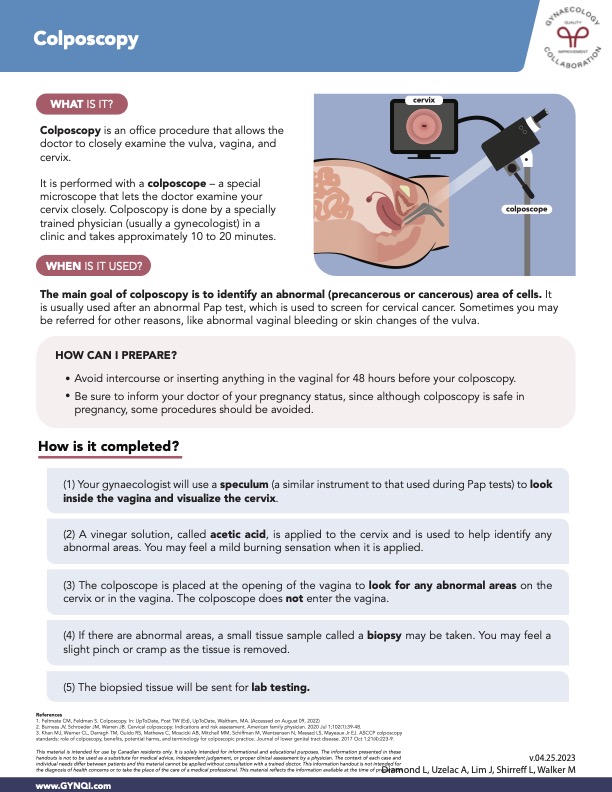
Table of Contents
- Summary
- What is a Colposcopy?
- When is a Colposcopy Required?
- How Can I Prepare for My Colposcopy?
- How is a Colposcopy Performed?
- Risks Associated with a Colposcopy
- Recovery After a Colposcopy
- When to Alert Your Healthcare Provider
- Results of a Colposcopy
- A Proactive Approach to Cervical Health
Summary:
- A colposcopy is a quick, in-office procedure performed by a trained gynaecologist using a colposcope. This specialized lighted microscope is used to closely examine the vulva, vagina and cervix for abnormal cells.
- Typically recommended after an abnormal Pap test, colposcopy aims to identify any precancerous or cancerous cells, and may also be advised for other concerns like unusual vaginal bleeding or changes in vulvar skin.
- To prepare, patients should avoid vaginal intercourse or inserting anything for 48 hours before the procedure. After a colposcopy, if a biopsy is performed, it’s essential to refrain from strenuous activities for 48 hours and avoid douching, tampons and intercourse for one week.
- Results are usually available within two to four weeks, with further treatment options based on whether abnormal cells (if found) are low-grade, which often resolve on their own, or are high-grade and may require removal or destruction through various procedures.
A colposcopy is a quick, in-office procedure performed by a gynaecologist to closely examine the vulva, vagina and cervix using a lighted microscope called a colposcope. Typically lasting 10 to 20 minutes, it is often conducted after an abnormal Pap test to identify any abnormal cells that may be precancerous or cancerous. The procedure is generally risk-free, however, if a biopsy is taken, there can be bleeding and pain experienced after the procedure. It is important to keep your doctor informed of your medical history and pregnancy status to help make the colposcopy process easy and effective.
What is a Colposcopy?
A colposcopy is an in-office procedure that allows the doctor to closely examine the vulva, vagina and cervix. It is performed with a colposcope–a special lighted microscope that lets the doctor examine your cervix closely. Colposcopy is done by a specially trained physician (usually a gynaecologist) in a clinic and takes approximately 10 to 20 minutes.
When is a Colposcopy Required?
The primary goal of a colposcopy is to pinpoint any abnormal cells that may be precancerous or cancerous. Typically performed following an abnormal Pap test (which screens for cervical cancer) a colposcopy may also be recommended for other concerns, such as unusual vaginal bleeding or changes in the skin of the vulva.
How Can I Prepare for My Colposcopy?
Avoid intercourse or inserting anything into the vagina for 48 hours before the examination, and inform your doctor of your pregnancy status. Colposcopy is safe in pregnancy, however, you can be at greater risk for bleeding if your doctor performs a biopsy.
How is a Colposcopy Performed?
A colposcopy is a quick examination that takes place in your doctor’s office or clinic. The exam follows these steps:
Step One: Your gynaecologist will use a speculum (similar to the instrument used during Pap tests) to look inside the vagina and visualize the cervix.
Step Two: A vinegar solution, called acetic acid, is applied to the cervix to help identify any abnormal areas. You may feel a mild burning sensation when it is applied.
Step Three: The colposcope is placed at the opening of the vagina to look for any abnormal areas on the cervix or in the vagina. The colposcope does not enter the vagina.
Step Four: If there are abnormal areas, a small tissue sample (referred to as a biopsy) may be taken for further analysis. You might feel a slight pinch or cramp as the tissue is removed.
Step Five: The biopsied tissue will be sent for lab testing.
Risks Associated with a Colposcopy
The colposcopy exam is a safe procedure, but there can be risks if a biopsy is taken. These risks, although small, can include:
- Bleeding: The risk of bleeding is small, and if anything, is usually very light spotting. After a biopsy is taken, a topical paste is applied to the site to control bleeding. You may notice brown or black clumpy discharge after the procedure if the topical paste is used.
- Infection: While the risk of infection is also small, it can present as post-procedure pelvic pain, discharge with pus, or abnormal bleeding or spotting.
Recovery After a Colposcopy
If during your colposcopy there was no biopsy taken, there are no restrictions recommended after the exam.
However, if a biopsy was taken during the colposcopy, it is important to avoid strenuous exercise for 48 hours, and avoid the following for one week after the procedure:
- Douching
- Tampons
- Intercourse
Avoid strenuous exercise for 48 hours afterwards.
If you notice any bleeding after the biopsy, you can wear a sanitary pad. It is normal to have some mild cramping, spotting, and dark or black-coloured discharge for a few days.
Over-the-counter painkillers including Tylenol and Advil can be used for cramping and discomfort.
When to Alert Your Healthcare Provider
Contact your doctor if you notice any of the following symptoms:
- Heavy bleeding
- Foul-smelling vaginal discharge
- Fever or chills
- Severe pelvic or lower abdominal pain
Results of a Colposcopy
Depending on the test ordered, the results of your colposcopy are generally available within two to four weeks. Your doctor will review these results with you, and if there are abnormal cells, the type of treatment recommended depends on your age and whether the abnormality is low-grade or high-grade.
Low-Grade Changes: Low-grade changes or abnormalities often go away on their own, and your doctor will arrange ongoing follow-up.
High-Grade Changes: Your doctor may suggest a procedure to remove or destroy the abnormal cells. This could include a loop electrosurgical excision procedure (LEEP) where the cells are removed, cryotherapy using cold chemicals to damage the abnormal cells, or laser surgery where laser energy destroys the abnormal cells.
Your doctor will discuss with you in more detail about the type of follow-up and treatment that is recommended for you.
A Proactive Approach to Cervical Health
A colposcopy is an effective in-office examination that closely examines the vulva, vagina and cervix for any abnormal cells. Typically recommended after an abnormal Pap test, it involves the use of a colposcope for detailed visualization of the cervix.
While generally safe, some risks may arise, particularly if a biopsy is taken. Results are usually available within two to four weeks, with guidance for further treatment based on the findings. Always consult with your healthcare provider for personalized advice and follow up with any questions you may have–they are there to help!

